FOOD FOR THOUGHT
- What is brand trust?
- Is it just marketing mumbo jumbo? Or is it something brands can actually build?
- How long does it take to build brand trust?
- What can erode or destroy it?
- Trusted Brands
- What’s in Your Closet
- In Nike We Trust – the #GOAT
- Brand Trust Exercise
The Most Trusted Brands in America
As our hitchhiker demonstrated, trust can be built in a flash. That’s powerful. What’s even more powerful is when trust is built and strengthened over time in a way that super glues consumers to their favorite brand or brands. That’s called Brand Trust.
Every year industry experts do research to determine which are the most trusted brands in the country. Below are some of the most trusted brands in 2022, according to Morning Consult. You can see the full report here.
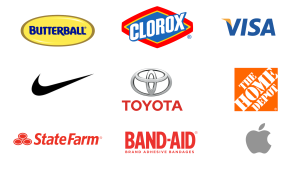 Are you surprised by any of these? Do you think any other brands deserve to be on the list?
Are you surprised by any of these? Do you think any other brands deserve to be on the list?
What’s in your closet?
The result of brand trust is sales. It’s the furniture, devices, food, cars, restaurant, and clothes you choose to buy. Consider what’s in your closet. How many of your clothes have a logo on them? Do you wear some of your t-shirts, sweatshirts, pants, and shoes more proudly than others? Why? Do they give you status not just because of how much they cost but because of the prestige and values associated with the brand?

Chances are you have at least one piece of clothing made by Nike. When deciding to wear each day, are you more likely to reach for something with a Nike logo on it? If so, you’re not alone. People all over the world proudly wear something with the Nike logo on it every day. In essence, they’re walking billboards. Why do consumers do this? Some studies suggest that wearing a large logo is similar to a male peacock displaying its feathers. Prominently displayed product logos could help you compete socially and even help you attract a mate. But not just any logo – a logo that provides social status. Why is a Nike logo a status symbol? BRAND TRUST. Below we’ll discuss how Nike became one of the most trusted brands in the world.
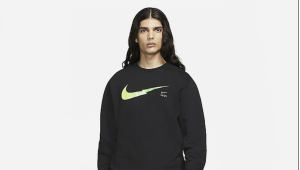
But first, let’s explore how brand trust influences behavior beyond the point of sale. How once you identify with a brand, it can affect your performance and even the way you think about the world. Watch this video to see how companies like Apple and Nike have managed to brand your brain and the brands of many consumers to the point that they and you are willing to pay more for them.

In Nike We Trust
Let’s dig deeper into why Nike is the #GOAT – the company that has remained one of the most trusted brands on the planet for decades.
Is it Nike’s products that make it so popular? Or Nike’s story?
Nike’s tagline “Just do it” is the most famous and enduring tagline of all time that speaks to the dreamer and the athlete in all of us. What does it mean? That inside every one of us is an athlete. Whether we’re young, old, weak, strong, an elite athlete, a weekend warrior, or a couch potato, we can unleash that inner athlete if we just try.

BTW, you can learn more about how this famous slogan came to be here: https://www.creativereview.co.uk/just-do-it-slogan/
But there’s more to Nike’s brand than its tagline. For decades, the company has told stories that connect and build trust with hundreds of millions of consumers. The result? Nike dominates in terms of market share.
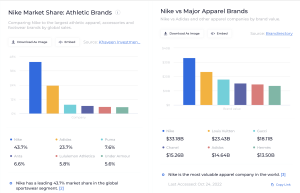
Watch this video that tracks how Nike hasn’t shrunk from standing up publicly for what the company believes in. It shows the financial and social impact of 30 years of embracing controversy and risk.
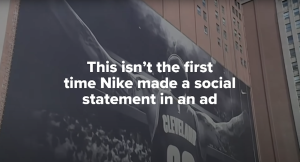
So here’s the question: which matters most – the gear or the mantra? The story or the kicks? Which has the most power to move consumers?

Nike has been telling the same story – of famous and not so famous athletes – for 30+ years. Nike’s story hasn’t changed. Nor have its values.
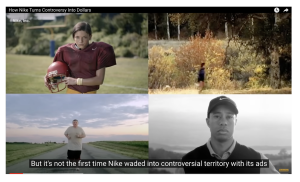
This video shows 25 years of Nike ads.
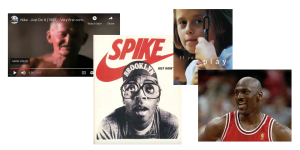
Nike has championed the dreamers, the outspoken, and social justice – even when it was controversial; even when it cost the company money.
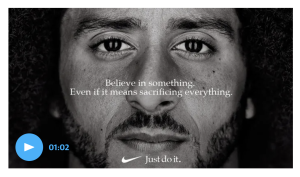
This consistent storytelling is why we trust Nike. It’s why we say YES to Nike.

Brand Trust is how brands like Nike influence our behavior way beyond the point of sale.
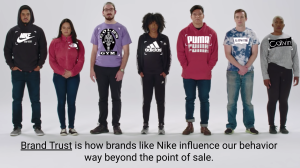
Brand Trust Exercise – ROAD TRIP
How does Brand Trust influence you in your every day life? Let’s do a quick exercise to help you find out…

Pretend you’re on a long road trip. It’s late at night. You’re driving on the interstate. The weather suddenly turns nasty and looks like it’ll get much worse before it gets better. You decide you don’t want to chance it. So you take an exit ramp to find a place for the night.
As you’re driving down the main street of the town, you see signs for these different hotels: Holiday Inn, Hampton Inn, La Quinta, and Marriott Hotel.
Which one do you pull into and why? Don’t overthink it. Make a snap decision.
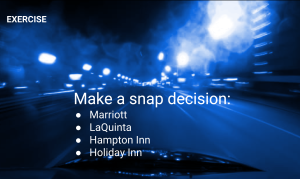
Which one would did you choose? Why did you choose it? Have you stayed there before? Has a family member or friend stayed there? What is it about the hotel’s reputation that might give you confidence it’s the right choice? Have you seen advertising that might’ve swayed you? Did you work there?

On the flip side, did you not choose one of other hotels because you stayed there and had a bad experience? Or maybe someone you know ranted about it? Or maybe you heard terrible word of mouth?

A brand’s reputation takes years to build. And every single interaction you have with it is crucial – from the advertising you might think is tone deaf, to the person who checks you, to a cute TikTok a friend posts. All of these help build trust with the brand – or break it. It only takes one bad interaction or impression to destroy brand trust that took decades to create.
Key Takeaways
Type your key takeaways here.
- First
- Second
When a consumer believes in the value of a product and company, and has a strong connection built over time.
